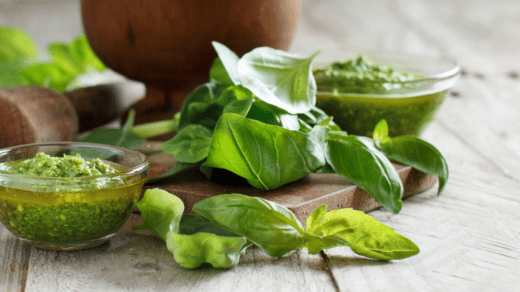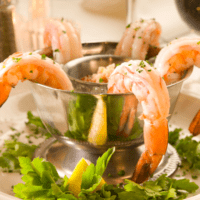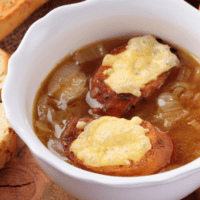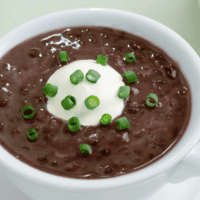Hey There! Some links on this page are affiliate links, which means that as an Amazon Associate, I may earn a small commission at no extra cost to you. I greatly appreciate your support! Learn more on my Affiliate Disclosure page.
Welcome to the world of homemade basil pesto sauce! If you’ve ever wondered how to make basil pesto that rivals the best Italian restaurants, you’re in for a treat. Pesto, a vibrant green sauce originating from Genoa, Italy, has been delighting taste buds for centuries.
Today, Chef Mark Sandoval will guide you through creating this aromatic, flavorful sauce in your kitchen. By the end of this article, you’ll have not just learned but mastered the art of making basil pesto that’s fresh, delicious, and versatile.
Why You Will Love This Recipe

Before diving into the nitty-gritty of pesto-making, let’s talk about why this recipe will become your new favorite.
First and foremost, the flavors of homemade pesto are unparalleled. The freshness of the basil, the richness of the olive oil, and the nuttiness of the pine nuts create a symphony of tastes that simply can’t be matched by store-bought versions.
Another great aspect of this recipe is its versatility. Once you’ve mastered the basic technique, you can easily customize it to suit your taste preferences. Want a bit more garlic kick? Go for it! Prefer a creamier texture? Add a touch more olive oil. The possibilities are endless, allowing you to create a pesto that’s uniquely yours.
Lastly, homemade pesto is incredibly versatile in its uses. While it’s traditionally served with pasta, you’ll find yourself using it as a spread on sandwiches, a dip for vegetables, or even as a marinade for meats. The convenience of having your own pesto at hand for various dishes will make you wonder how you ever lived without it!
Ingredients You’ll Need

Before we start cooking, let’s review the ingredients you’ll need for this recipe. Each component plays a crucial role in creating that perfect pesto flavor and texture.
| INGREDIENT | QUANTITY | NOTES |
|---|---|---|
| Garlic | 6 cloves | Blanched |
| Extra virgin olive oil | 1 cup | High-quality for best flavor |
| Basil leaves | 2 cups | Blanched and shocked |
| Pine nuts | 1/2 cup | It can be lightly toasted |
| Salt | To taste | Sea salt or kosher salt recommended |
| Cracked pepper | To taste | Freshly cracked for best flavor |
| Boiling water | As needed | For blanching |
| Iced Water | As needed | For shocking basil |
Let’s briefly discuss each ingredient:
- Garlic: Blanching the garlic helps mellow its sharp flavor, resulting in a smoother pesto.
- Extra virgin olive oil: The backbone of any good pesto. Choose a high-quality oil for the best flavor.
- Basil leaves: The star of the show. Blanching and shocking helps preserve their vibrant green color.
- Pine nuts: These add a delightful nutty flavor and creamy texture to your pesto.
- Salt and pepper: Essential for seasoning and enhancing all the flavors.
- Boiling water and ice water: These are used in the blanching and shocking process for both the garlic and basil.
Kitchen Tools You’ll Need

Now that we’ve covered the ingredients, let’s look at the tools you’ll need to make your pesto like a pro.
| TOOL | PURPOSE |
|---|---|
| Saucepan | You’ll use this to boil water to blanch the garlic and basil. |
| Large skimmer | This helps you quickly remove the blanched items from the boiling water. |
| Blender | Essential for creating that smooth, creamy pesto texture. |
| Chinois | A fine-meshed conical strainer that’s perfect for blanching basil leaves. |
| Kitchen towels | Always handy in the kitchen for various uses. |
| Large container | You’ll use this to create an ice bath to shock the blanched basil. |
| Kitchen bowl | Useful for mixing and holding ingredients. |
| Measuring spoon set | For accurate measurements of your ingredients. |
Step-By-Step Recipe Instructions
Now that our ingredients and tools are ready let’s begin the pesto-making process. Follow these steps carefully, and you’ll be rewarded with a delicious, homemade basil pesto sauce.
Prepare the ice bath:
- Start by filling your large container with cold water and ice. This will shock the basil leaves after blanching, helping to preserve their vibrant green color.
Blanch the garlic:
- Bring water to a boil in your saucepan.
- Add the garlic cloves and let them boil for about 30 seconds. This process helps mellow the garlic’s sharp flavor.
- Use your skimmer to remove the garlic and set it aside to cool.
Blanch and shock the basil:
- Using the same boiling water, blanch the basil leaves for just 5-10 seconds.
- Quickly remove them with the skimmer and immediately plunge them into the prepared ice bath. This process, known as shocking, stops the cooking process and helps maintain the basil’s bright green color.
Toast the pine nuts:
- In a dry pan over medium heat, lightly toast the pine nuts until golden brown and fragrant.
- Be careful not to burn them – they can go from perfectly toasted to burnt very quickly!
Blend the ingredients:
- Combine the blanched garlic, shocked basil leaves, toasted pine nuts, and about half of the olive oil in your blender.
- Blend until the mixture starts to come together, then slowly drizzle in the remaining olive oil while the blender is running. This helps create a smooth, emulsified sauce.
Adjust seasoning:
- Add salt and freshly cracked pepper to taste.
- Blend again briefly to incorporate. Remember, you can always add more seasoning, but you can’t take it away, so start with a little and adjust as needed.
Congratulations! You’ve just made your very own basil pesto sauce. The aroma alone is enough to make your mouth water, isn’t it?
Tips, Tricks, and Storage Options

Now that you’ve mastered the basic recipe, let’s explore some tips and tricks to elevate your pesto game and discover the best ways to store your delicious creation.
| TOPIC | DETAILS |
|---|---|
| Blanching techniques | When blanching the basil, work in small batches to ensure each leaf is properly blanched. Use the chinois to submerge the leaves in the boiling water—it makes the process much easier and faster. |
| Choosing the best olive oil | The quality of your olive oil significantly impacts the flavor of your pesto. Opt for a high-quality, extra virgin olive oil. It might be more expensive, but the difference in taste is worth it. |
| Proper storage methods | If you’re not using your pesto right away, transfer it to an airtight container. Pour a thin layer of olive oil on top to prevent oxidation, which can cause the pesto to turn brown. Stored this way in the refrigerator, your pesto should last for up to a week. |
| Freezing options | Pesto freezes beautifully! Pour it into ice cube trays for convenient, portion-sized servings. Once frozen, transfer the cubes to a freezer bag. They’ll keep for up to 3 months. |
Serving Suggestions and Pairings

Your homemade pesto is incredibly versatile. Here are some delicious ways to enjoy it:
- Classic pasta dishes: Toss your pesto with hot pasta for a quick and delicious meal. It pairs particularly well with long pasta shapes like spaghetti or linguine.
- Use as a spread or dip: Spread pesto on sandwiches or use it as a dip for fresh vegetables or breadsticks. It’s a great way to add a burst of flavor to simple snacks.
- Incorporate into other recipes: Use pesto as a pizza sauce, mix it into salad dressings, or use it to marinate chicken or fish before grilling. The possibilities are endless!
Conclusion

Making basil pesto at home is a rewarding experience that yields a sauce far superior to anything you can buy in a store. The fresh, vibrant flavors of homemade pesto will elevate your dishes and impress your family and friends. With this recipe in your culinary arsenal, you’re well on your way to creating restaurant-quality meals in your own kitchen.
Remember, cooking is all about experimentation and finding what works best for you. Don’t be afraid to adjust the recipe to suit your taste preferences. Maybe you’ll discover a unique twist that becomes your signature pesto recipe!
We’d love to hear about your pesto-making adventures! Did you try this recipe? How did it turn out? Did you make any interesting modifications? Share your experiences in the comments below.
If you enjoyed this recipe and want more culinary tips and tricks, don’t forget to subscribe to our blog. We’re always cooking up new and exciting recipes to share with our readers.
Happy pesto-making!
FAQs

Why blanch the garlic and basil?
Blanching garlic mellows its sharp flavor, resulting in a smoother pesto. Blanching basil helps maintain its vibrant green color.
Can I use different nuts instead of pine nuts?
Absolutely! Walnuts, almonds, or even pistachios can be great alternatives. Each will lend a unique flavor to your pesto.
How long does homemade pesto last?
Properly stored in the refrigerator, homemade pesto can last up to a week. For longer storage, you can freeze it for up to three months.
Can I freeze pesto?
Yes, pesto freezes well. Freeze it in ice cube trays for convenient, portion-sized servings.
What’s the best pasta to serve with pesto?
Long pasta shapes like spaghetti or linguine work well with pesto. However, any pasta shape you enjoy will work!
Is pesto healthy?
Pesto contains healthy fats from olive oil and nuts and nutrients from basil. However, it’s calorie-dense, so enjoy it in moderation.
Can I make pesto without a blender?
Yes, you can use a food processor or even make it by hand with a mortar and pestle. The texture might be slightly different, but still delicious.
How can I prevent my pesto from turning brown?
Before storing, cover the surface of your pesto with a thin layer of olive oil. This prevents oxidation, which causes browning.
Can I use dried basil instead of fresh?
Fresh basil is strongly recommended for the best flavor and texture. Dried basil won’t produce the same vibrant, fresh taste.
Hey There! Some links on this page are affiliate links, which means that as an Amazon Associate, I may earn a small commission at no extra cost to you. I greatly appreciate your support! Learn more on my Affiliate Disclosure page.


























